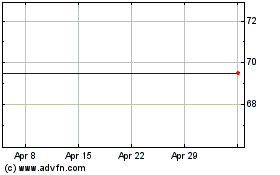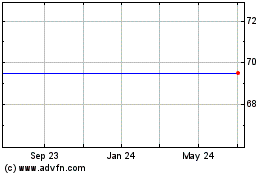Ball Aerospace Celebrates 21 Years of Ozone Research
October 20 2005 - 3:22PM
PR Newswire (US)
BOULDER, Colo., Oct. 20 /PRNewswire-FirstCall/ -- Ball Aerospace
& Technologies Corp. recently celebrated the retirement of one
of the longest-running spacecraft missions to date. The Earth
Radiation Budget Satellite (ERBS) was launched in 1984 on the Space
Shuttle Challenger as the first spacecraft specifically designed to
be launched by the Shuttle. Ball Aerospace was responsible for the
spacecraft bus and the Stratospheric Aerosol Gas Experiment (SAGE
II), one of the three instruments onboard. In 1984, the ERBS was
expected to have a two-year design life, but the mission continued
to return useful scientific data about the Earth's ozone layer for
more than two decades. "ERBS delivered tremendous scientific value
over its lifespan," says David L. Taylor, president and chief
executive officer of Ball Aerospace & Technologies Corp. "Its
return on investment, calculating length of service and technical
achievement combined, must be enormous. The ERBS spacecraft raised
the bar for on-orbit performance." The ERBS was part of NASA's
three-satellite Earth Radiation Budget Experiment (ERBE), designed
to investigate how energy from the sun is absorbed and re-emitted
by the Earth. This process of absorption and re-radiation is one of
the principal drivers of the Earth's weather patterns. Observations
from the ERBS were also used to determine the effects of human
activities (such as burning fossil fuels and the use of CFCs) and
natural occurrences (such as volcanic eruptions) on the Earth's
radiation balance. Although the ERBS continued to return data from
the SAGE II and ERBE instruments, newer spacecraft missions are
producing improved data, making the funding for the mission
unjustifiable. SAGE II and the Earth Radiation Budget Experiment
instruments onboard the ERBS were turned off on Sept. 8. The ERBS
was officially retired Oct. 14 after all remaining fuel was vented.
The spacecraft is expected to drift in space until it disintegrates
as it re-enters the Earth's atmosphere in approximately 18 years.
The ozone studies for which the ERBS provided data helped to
motivate an international community to develop the Montreal
Protocol Agreement, resulting in the virtual elimination of CFCs.
These chemicals were found harmful to the ozone based, in part, on
the wealth of data the ERBS returned on the chemistry and motions
of the Earth's upper troposphere and stratosphere. As a result, new
ozone-friendly technologies were developed for air conditioning,
refrigeration and industrial uses. Ball Corporation (NYSE:BLL) is a
supplier of metal and plastic packaging products, primarily for the
beverage and food industries. The company also owns Ball Aerospace
& Technologies Corp., which develops sensors, spacecraft,
systems and components for government and commercial markets. Ball
Corporation employs more than 13,500 people and reported 2004 sales
of $5.4 billion. Forward-Looking Statements The information in this
news release contains "forward-looking" statements and other
statements concerning future events and financial performance.
Words such as "expects," "anticipates," "estimates," and variations
of same and similar expressions are intended to identify
forward-looking statements. Forward-looking statements are subject
to risks and uncertainties which could cause actual results to
differ materially from those expressed or implied. The company
undertakes no obligation to publicly update or revise any
forward-looking statements, whether as a result of new information,
future events or otherwise. Key risks and uncertainties are
summarized in the company's filings with the Securities and
Exchange Commission, especially in Exhibit 99.2 in the most recent
Form 10-K. These filings are available at our Web site and at
http://www.sec.gov/. Factors that might affect our packaging
segments include fluctuation in consumer and customer demand;
availability and cost of raw materials, including due to the
effects of hurricanes Katrina and Rita, as well as recent
significant increases in resin, steel, aluminum and energy costs,
and the ability to pass such increases on to customers; competitive
packaging availability, pricing and substitution; changes in
climate and weather; fruit, vegetable and fishing yields; industry
productive capacity and competitive activity; failure to achieve
anticipated productivity improvements or production cost
reductions, including those associated with our beverage can end
project; the German mandatory deposit or other restrictive
packaging laws; changes in major customer or supplier contracts or
loss of a major customer or supplier; international business risks,
including foreign exchange rates, tax rates and activities of
foreign subsidiaries; and the effect of LIFO accounting on
earnings. Factors that might affect aerospace segment include:
funding, authorization and availability of government contracts and
the nature and continuation of those contracts; and technical
uncertainty associated with segment contracts. Factors that could
affect the company as a whole include those listed plus:
acquisitions, joint ventures or divestitures; regulatory action or
laws including tax, environmental and workplace safety;
governmental investigations; goodwill impairment; antitrust and
other litigation; strikes; boycotts; labor cost changes; rates of
return projected and earned on assets of the company's defined
benefit retirement plans; reduced cash flow; interest rates
affecting our debt; and changes to unaudited results due to
statutory audits or management's evaluation of the company's
internal control over financial reporting. DATASOURCE: Ball
Aerospace & Technologies Corp. CONTACT: Media, Emilia Reed of
Ball Aerospace & Technologies Corp., +1-303-533-6059, Web site:
http://www.ballaerospace.com/
Copyright
Ball (NYSE:BLL)
Historical Stock Chart
From Jun 2024 to Jul 2024

Ball (NYSE:BLL)
Historical Stock Chart
From Jul 2023 to Jul 2024
